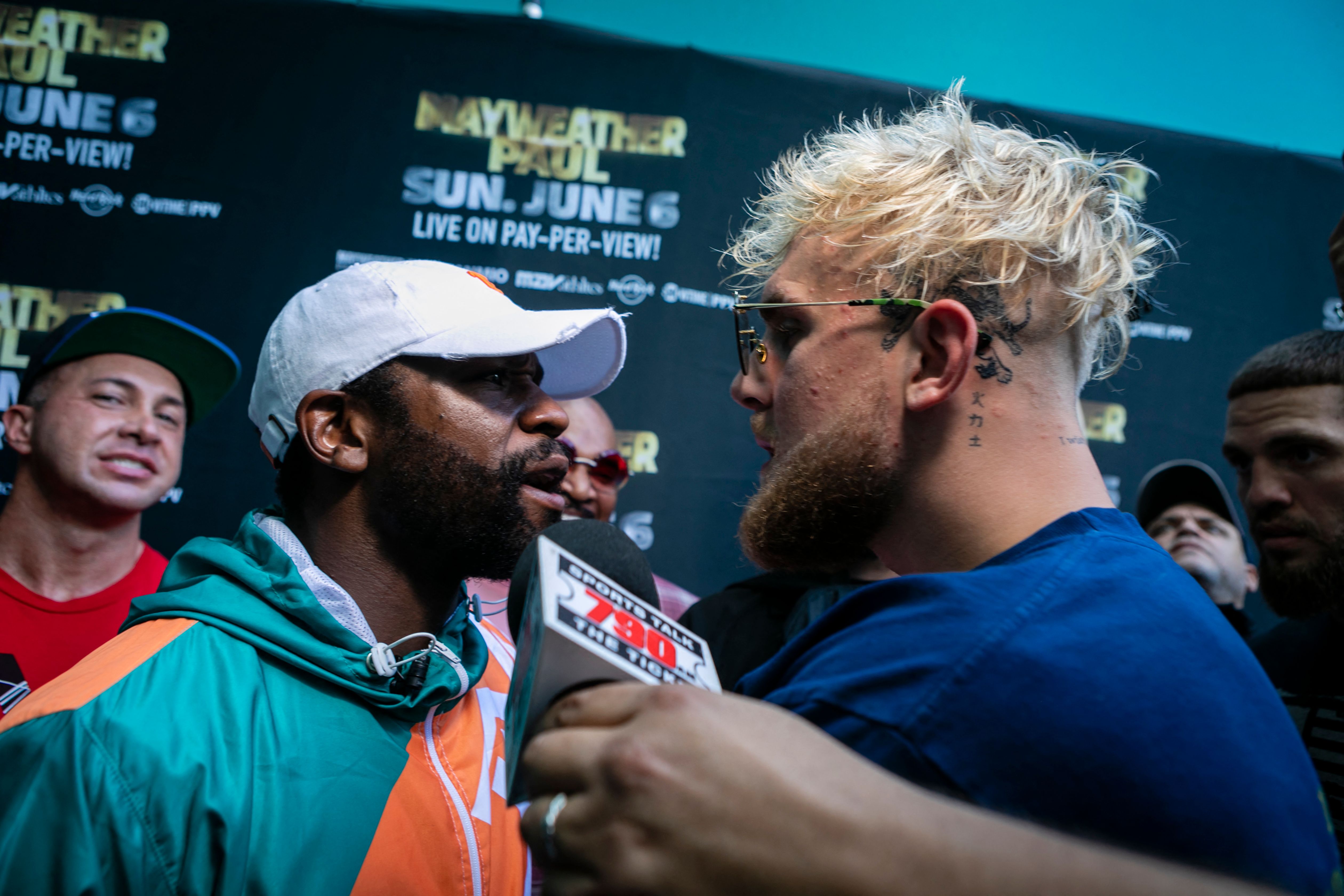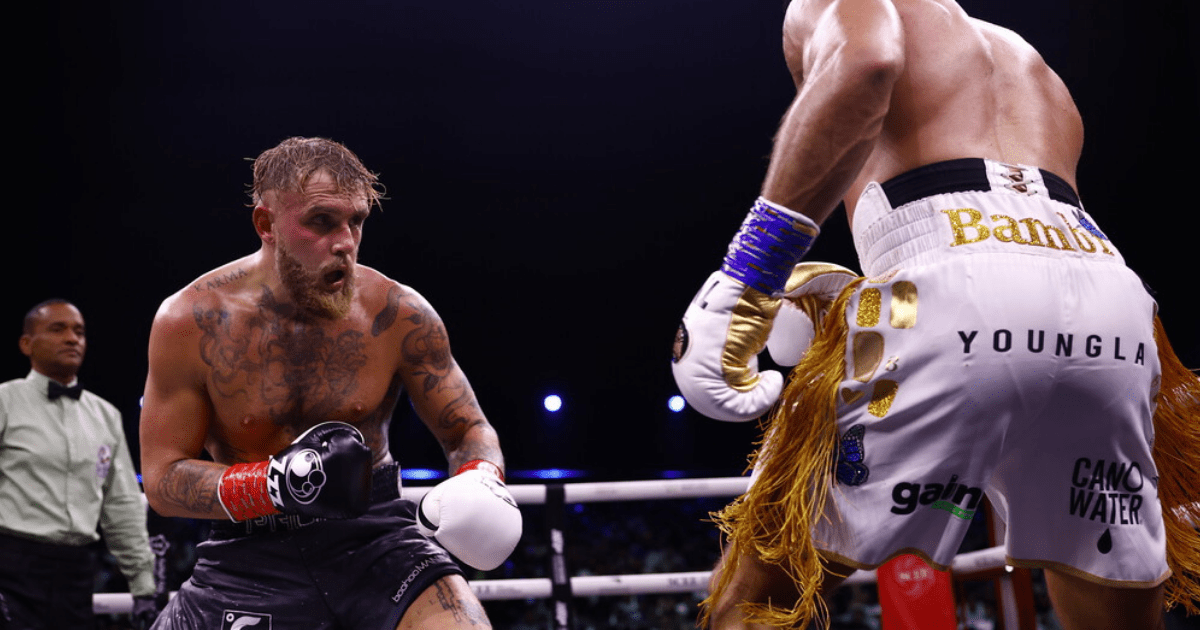JAKE PAUL has called out Floyd Mayweather to a “real fight” after turning down “numerous” exhibition offers.
Mayweather officially retired in 2017 after beating ex-UFC champion Conor McGregor but he has returned for six exhibitions since.
Jake Paul has called out Floyd Mayweather to a ‘real fight’
Floyd Mayweather has boxed in six exhibitions
One was against Paul’s brother Logan in June 2021, which went the full eight round distance.
A month beforehand, the YouTuber-turned boxer clashed with Mayweather at a press conference, stealing his hat and sparking a mass brawl.
It has kept the feud brewing so much so that Paul was confronted by the boxing legend and his entourage after a Miami Heat match.
Paul was filmed running away from the altercation and later hit out at Mayweather, offering to settle it in the ring with their records on the line.
He said: “Floyd will not see me 1 on 1 in a real fight. That’s a fact. His team has hit my team numerous times to do one of his “exhibitions”.
“Now he ambushes me. Come see me in the ring, real fight, no exhibition robbing fans bulls***.”
Paul, 26, was just beaten for the first time in seven professional bouts, losing to Tommy Fury, 23.
The pair are now targeting a rematch in the summer following Fury’s split-decision victory in Saudi Arabia.
One night before, Mayweather, 46, rolled back the clock against Geordie Shore’s Aaron Chalmers, 35, in his UK boxing debut.
Paul has maintained he will only fight the American icon if it is professionally sanctioned with his 50-0 record at stake.
But the weight disparity makes the bout almost impossible to overcome with Mayweather never weighing more than 11st.
Meanwhile, Paul was around 13st for his loss to Fury, meaning there is TWO STONE between them.
The social media sensation in the past has offered to fight Mayweather at 175lb, with his rival coming in at 165lb to bridge the weight gap.
 Floyd Mayweather and Jake Paul were involved in a melee in 2021
Floyd Mayweather and Jake Paul were involved in a melee in 2021
Frequently Asked Questions
How can I box without a partner?
You can practice boxing by watching professional matches on TV, even if your partner is not available. Or you can find an amateur boxing club near you. Regular training sessions are a common feature of amateur boxing clubs. These sessions typically include sparring partners that hit pads together.
You can also train boxing with punching bags. Before hitting the bag you should make sure you are wearing protective gear, such as gloves.
How long does it take for boxers to train each day?
Boxing trainers work out for at least 4 hours each day. They also learn new moves and practice punches. Boxers may spar up to ten times per week.
What are the different types and uses of boxing gloves?
There are three types of boxing gloves available: mitts and fingerless mitts. Mitten gloves have padding at the knuckles. Fingerless mitts are not padded around the knuckles and still cover the fingers. Full-fingered gloves have padding around the entire hand.
Mittens are useful for striking the fist or punching. For striking or punching with the index finger’s knuckle, mitt gloves can be used. Boxing gloves that are full-fingered can be used to punch with your whole fist.
How long does it take for a professional boxer to become one?
To become a professional boxer, it takes dedication and years of hard work. A minimum of 10 hours per week is required to train to become a professional ring fighter.
What are the benefits to learning how to box?
These are the reasons you need to learn how box.
- It builds confidence. Learn to box can give you courage to confront bullies or any other person who might bully you.
- It improves your overall health. Boxing can help build muscle mass. Muscle mass is what makes you stronger.
- It teaches self defense skills. When you learn how to fight, you learn how to protect yourself.
- It develops your mental toughness. You need mental toughness to face difficult situations.
- It can give you a feeling of accomplishment. Once you have learned a technique you’ll feel like you are a real boxer.
- It’s fun! It’s fun!
- It’s cheap. It only takes a pair if boxing gloves, and a punchingbag.
- It doesn’t take up much space
Statistics
- It is just like normal sparring with a partner, but you want to throw punches at 75% of your normal speed. (wikihow.com)
- You want to be running at roughly 75-80% of your top speed..5 mile slow, easy recovery jog at the end.[6]X Research source 2Mix in long runs, shadow boxing, and short sprints on non-interval days. (wikihow.com)
External Links
en.wikipedia.org
boxandflow.com
How To
How to learn how to box for fitness
How to learn how to box for Exercise
Your goal in learning boxing is self-confidence and improvement of your physical fitness. Boxing is one of the most popular sports in the world. It requires speed, strength, agility, stamina and coordination.
Boxing is an excellent way to lose weight and feel great about yourself. It will be a fun activity that you will want to do again and again.
There are many types of boxing training programs. You can choose to train in a gym or at home. Others require that you go to a health club. You can also study online from any location in the world.
Be sure to consider your goals when choosing a program. Also, ensure it fits your lifestyle. The best programs include exercises designed to build muscle mass, increase flexibility, improve cardiovascular endurance, and enhance overall well-being.
Also, consider whether you prefer an advanced or beginner course. Beginner’s courses usually cover basic techniques such as shadowboxing or sparring, mittwork and punching combinations. Advanced programs typically offer a wider variety of exercises and cover more complex movements.
These programs are generally less expensive than $100 and last for eight weeks. These programs don’t give any nutritional, weight loss, or injury prevention advice.
Advanced programs generally last around six months and cost approximately $300. They often include nutritional advice, stretching routines, warm-up exercises, and instruction on proper technique. In addition, some programs incorporate resistance training (such as lifting weights) and aerobic conditioning (such as running).

